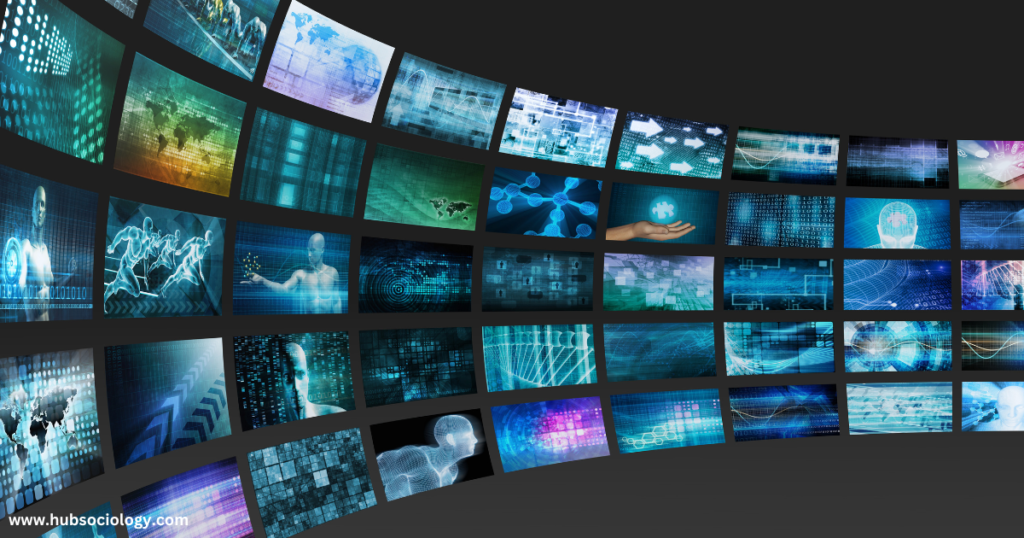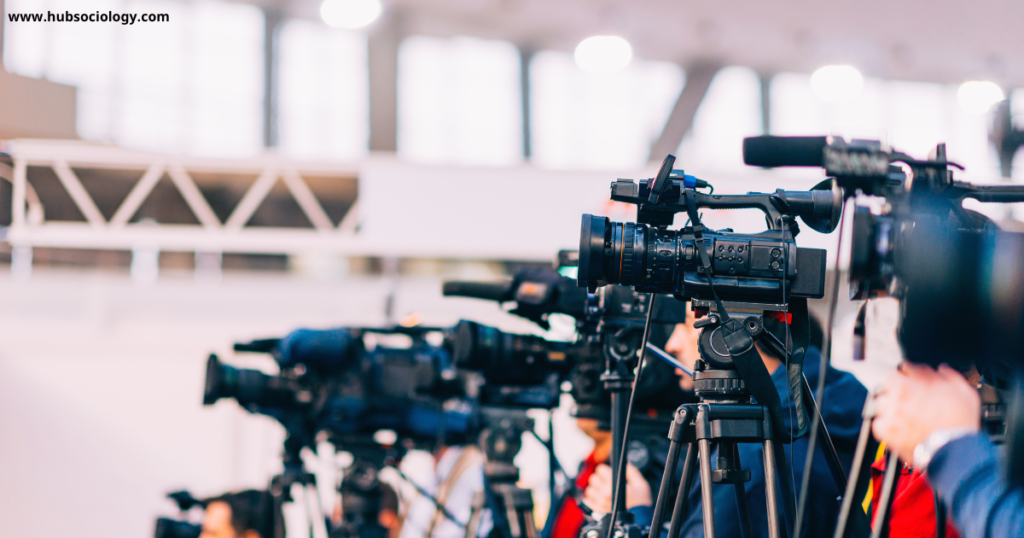Introduction of Conflict Theory Perspectives on Media
The media plays a crucial role in shaping public opinion, disseminating information, and reinforcing societal norms. From a sociological perspective, the media is not just a neutral platform for communication but also a site of power struggles, ideological domination, and social control. Conflict theory, rooted in the works of Karl Marx and later expanded by theorists such as Antonio Gramsci and C. Wright Mills, provides a critical lens to examine how the media perpetuates inequalities, serves elite interests, and marginalizes dissenting voices.

This article explores conflict theory perspectives on media, focusing on:
- Media Ownership and Corporate Control
- Ideological Hegemony and Propaganda
- Media Representation and Social Inequality
- The Role of Media in Social Movements and Resistance
By analyzing these dimensions, sociology students can better understand how media institutions function within broader structures of power and domination.
1. Media Ownership and Corporate Control
Concentration of Media Power
Conflict theorists argue that media ownership is concentrated in the hands of a few powerful corporations, leading to a homogenization of content that aligns with elite interests. Large conglomerates such as Disney, News Corp, Comcast, and Warner Bros. dominate global media, controlling news outlets, entertainment platforms, and digital media spaces. This concentration raises concerns about:
- Limited diversity of perspectives – When a small group controls media narratives, alternative viewpoints are often excluded.
- Profit-driven journalism – Corporate media prioritizes sensationalism and entertainment over investigative journalism, undermining democratic discourse.
- Political and economic biases – Media corporations often align with political elites and corporate advertisers, shaping news to fit their agendas.
The Propaganda Model (Herman & Chomsky)
Edward Herman and Noam Chomsky’s propaganda model (1988) explains how corporate media functions as a tool for elite manipulation. They identify five filters that shape media content:
- Ownership – Media is owned by wealthy elites who influence editorial policies.
- Advertising – Media relies on corporate advertisers, discouraging content that criticizes capitalism.
- Sourcing – News outlets depend on government and corporate sources, leading to biased reporting.
- Flak – Dissenting voices face backlash, discouraging critical journalism.
- Anti-ideologies – Media promotes fear of external threats (e.g., communism, terrorism) to justify elite policies.
This model suggests that mainstream media does not serve the public interest but rather reinforces the status quo.
2. Ideological Hegemony and Propaganda
Gramsci’s Concept of Cultural Hegemony
Antonio Gramsci’s theory of cultural hegemony explains how ruling classes maintain dominance not just through force but by shaping cultural norms and ideologies. The media plays a key role in this process by:
- Normalizing capitalist values – Promoting consumerism, individualism, and acceptance of economic inequalities.
- Marginalizing radical critiques – Alternative political perspectives (e.g., socialism, anti-racism) are often dismissed as “extremist.”
- Manufacturing consent (Chomsky) – The media convinces the public to accept policies that benefit elites, such as deregulation and militarization.
Media as a Tool for Social Control
Conflict theorists argue that the media distracts and pacifies the public through:
- Entertainment over education – Reality TV, celebrity gossip, and sensational news divert attention from systemic issues.
- Fear-mongering – Excessive coverage of crime and terrorism fosters support for authoritarian policies.
- False consciousness (Marx) – The media perpetuates ideologies that prevent the working class from recognizing their exploitation.
3. Media Representation and Social Inequality

Class Bias in Media Portrayals
The media often reinforces class hierarchies by:
- Glamorizing wealth – Celebrity culture and business success stories promote the myth of meritocracy.
- Demonizing the poor – Welfare recipients and the unemployed are often portrayed as lazy or irresponsible.
- Underrepresenting working-class struggles – Labor strikes and economic injustices receive less coverage than corporate interests.
Racial and Gender Stereotypes
Conflict theory highlights how media reproduces racial and gender inequalities:
- Racial bias – People of color are often stereotyped as criminals (e.g., overrepresentation of Black men in crime news) or exoticized in entertainment.
- Gender roles – Women are frequently sexualized or confined to domestic roles, while men dominate positions of authority in news and film.
- Lack of diversity in media ownership – White, male elites control most media institutions, shaping narratives that uphold patriarchal and racist structures.
Framing and Agenda-Setting
The media influences public perception through:
- Framing – Presenting issues in a way that guides interpretation (e.g., framing protests as “riots” to delegitimize dissent).
- Agenda-setting – Deciding which issues are newsworthy, often ignoring systemic problems like poverty and corporate corruption.
4. The Role of Media in Social Movements and Resistance
Counter-Hegemonic Media
While mainstream media reinforces elite dominance, alternative and independent media provide platforms for resistance:
- Social media activism – Movements like #BlackLivesMatter and #MeToo bypass traditional media to challenge systemic oppression.
- Independent journalism – Outlets like The Intercept and Democracy Now! expose corporate and government abuses.
- Community media – Grassroots media projects amplify marginalized voices that corporate media ignores.
Media as a Battleground for Ideological Struggle
Conflict theorists emphasize that media is not just a tool of oppression but also a site of contestation. Social movements use media to:
- Challenge dominant narratives – Exposing police brutality, environmental destruction, and labor exploitation.
- Mobilize public opinion – Viral campaigns can pressure governments and corporations to enact change.
- Promote solidarity – Media connects activists across borders, fostering global resistance movements.
Conclusion on Conflict Theory Perspectives on Media
From a conflict theory perspective, the media is a powerful institution that reinforces social inequalities, sustains elite dominance, and manipulates public consciousness. Corporate control, ideological hegemony, and biased representations ensure that media serves the interests of the powerful rather than the public. However, media also serves as a space for resistance, where marginalized groups can challenge dominant narratives and advocate for social change.
For sociology students, understanding these dynamics is crucial for critically engaging with media content and recognizing its role in perpetuating or challenging systemic injustices. By questioning media structures and supporting independent journalism, individuals can contribute to a more democratic and equitable media landscape.

Topic Related Questions on Conflict Theory Perspectives on Media
5-Mark Questions on Conflict Theory Perspectives on Media (Short Answer)
- Define functionalism in sociology.(2 marks)
- Briefly explain its key assumptions. (3 marks)
- List any three functions of the media according to functionalism. (5 marks)
- How does the media contribute to socialization? (5 marks)
- What is the role of the media in information dissemination? (5 marks)
- Explain how the media provides entertainment from a functionalist perspective. (5 marks)
- What is the “correlation function” of the media in functionalism? (5 marks)
- How does the media act as an agent of social control? (5 marks)
- Explain the term “cultural transmission” in relation to media. (5 marks)
- Give one example of how the media reinforces dominant ideologies. (5 marks)
- Why do functionalists argue that entertainment media is important for society? (5 marks)
10-Mark Questions on Conflict Theory Perspectives on Media (Brief Essay/Structured Response)
- Discuss the functionalist view of the media in maintaining social order.(10 marks)
- Key functions (information, socialization, correlation, entertainment, mobilization).
- Examples of media reinforcing norms.
- Evaluate the role of the media in socialization and cultural transmission.(10 marks)
- How media teaches norms and values.
- Examples (children’s TV, news framing).
- Compare functionalist and Marxist perspectives on media ownership and control.(10 marks)
- Functionalism: Media as beneficial for society.
- Marxism: Media as a tool for ideological control.
- How does the media help in the correlation of different parts of society?(10 marks)
- Media framing of events.
- Influence on public opinion and policy.
- Assess the functionalist argument that the media promotes social stability.(10 marks)
- Strengths (shared norms, crisis communication).
- Weaknesses (ignores bias, commercialization).
- “The media helps maintain social cohesion.” Discuss this view from a functionalist perspective.(10 marks)
- How does functionalism explain the media’s role in political socialization?(10 marks)
- Media’s influence on political awareness.
- Examples (news coverage, political ads).
- Criticisms (bias, agenda-setting).
- Evaluate the functionalist claim that the media promotes democracy.(10 marks)
- Information dissemination & public debate.
- Counterarguments (media monopolies, fake news).
- Compare functionalist and pluralist views on media diversity.(10 marks)
- Functionalism: Media reflects shared values.
- Pluralism: Media offers varied viewpoints.
- Which is more convincing?
- How does the media contribute to economic stability from a functionalist perspective?(10 marks)
15-Mark Questions on Conflict Theory Perspectives on Media (Extended Essay/Critical Analysis)
- Examine the functionalist perspective on the media’s role in society.(15 marks)
- Key functions (information, socialization, entertainment, mobilization).
- Criticisms (corporate control, passive audience assumption).
- Conclusion: Is functionalism still relevant today?
- “The media serves the interests of society as a whole.” Evaluate this statement from a functionalist perspective.(15 marks)
- Functions like education, socialization, and cohesion.
- Counter-arguments (media bias, profit motives).
- Final judgment: Does media truly benefit everyone?
- Compare and contrast functionalist and conflict perspectives on the media.(15 marks)
- Functionalism: Media promotes stability.
- Conflict theory (Marxism): Media reinforces inequality.
- Which view is more convincing?
- How far do you agree that the media reinforces social norms and values?(15 marks)
- Functionalist view: Media as a socialization tool.
- Critiques: Media challenges norms (e.g., progressive movements).
- Conclusion: Media both reinforces and changes norms.
- Assess the impact of digital media on traditional functionalist views of the media.(15 marks)
- Does digital media still perform the same functions?
- New challenges (misinformation, echo chambers).
- Is functionalism outdated in the digital age?
- “Functionalism overstates the media’s positive role in society.” Evaluate this statement.(15 marks)
- Analyze how functionalists and postmodernists differ in their views on media influence.(15 marks)
- Functionalism: Media reinforces stability.
- Postmodernism: Media creates fragmented realities.
- Case studies (social media vs. traditional media).
- To what extent does the media reflect or shape societal values?(15 marks)
- Functionalist view: Media mirrors/shapes norms.
- Conflict view: Media imposes elite ideologies.
- Evidence (e.g., gender roles in advertising).
- Assess the impact of globalization on functionalist theories of the media.(15 marks)
- Does global media still promote national cohesion?
- Challenges (cultural imperialism, hybrid identities).
- “The rise of digital media has made functionalist perspectives outdated.” Discuss.(15 marks)
Bonus: Application-Based Questions
- Apply functionalism to analyze a recent news event (e.g., COVID-19 coverage). (10 marks)
- How would a functionalist interpret the popularity of reality TV shows? (5 marks)
- Using functionalism, explain why governments regulate media content. (10 marks)

1 thought on “Conflict Theory Perspectives on Media”